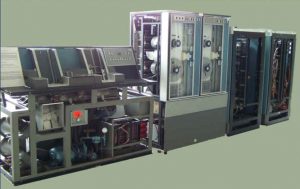ICT 1905 computer
International Computers and Tabulators (ICT), later International Computers Limited (ICL), entered the market in the first half of the 1960s with its 1900 family of machines, which gradually became more powerful.
The Model 1905 (pictured) was the mid-performance member of the series.
Use
n.a.
In our country, KFKI was the first to purchase an ICT 1905 machine in 1964; later, the Hungarian Central Statistical Office and Csepel Vas és Fémművek also acquired one each.
In 1968, the National Leadership Training Center received an ICL 1906 computer.
In 1969, NIM IGÜSZI, together with the Pharmaceutical Industry Association, purchased an ICL 1903A computer; with the dissolution of NIM (1984), it was transferred to the Sensor Organization Company.
Structure
Central unit
Word-organized machine: 24 bpW
- controller: 1905 processor
- 8 general registers (24 bits), including 3 index registers
- a 48-bit floating-point register
- main magazine: 32 KW ferrite ring magazine, made of 1 KW plates
- cycle time 2 μs
- automatic parity check
- calculator:
- fixed-point / decimal ALU
- separate floating point arithmetic
- channel:
- 18 low-speed interfaces
- 5 fast interfaces
Periphery
- backup:
- 7-track ½” magnetic tape
- 7.25 MB removable magnetic disk
- external devices:
- control console typewriter
- 8-track punched tape reader and puncher
- punch card reader and puncher
Detailed description of the central unit: Central Processor (English)
Operation
The multiprogrammable processor could run 4 program tasks simultaneously, while handling both slow and fast peripheral devices in parallel on each channel, in a time-sharing system.
“Data transfer operations started with a delay of 6 μs” — this not very precise wording probably refers to the cycle time of the time division.
The calculator
- 24-bit 2's complement fixed-point binary numbers,
- with 47-bit floating-point numbers (38-bit 2's complement mantissa, 9-bit fixed-point integer exponent), and
- With 6-bit characters (4 chpW)
operations performed.
Operation types:
- basic fixed-point and floating-point operations
- basic decimal operations (automatic conversion)
- character operations
Program set
- operating system:
- Executive (ICT development)
- George-3
- programming languages:
- PlLAN assemble
- Fortran 66
- Algol 60
- Cobol
A number of application software packages have also been developed for the machine family; some examples include:
Scan – warehouse inventory systemPert – project planning and implementation support system- Prosper – financial planning system
- NIMMS – production management system
- ComPay – corporate payroll system
- DataDrive and DataView – a system for managing large data files
- Find – data retrieval system for large data sets, etc.
These were delivered with the machines as required.
Historical curiosities
The 1900 series also owes its success to the fact that the operating systems had excellent multiprogramming capabilities.
In the 1960s and 1970s, ICL released several improved versions (1990A, E, FS, T), and several companies produced clones based on the licenses sold; among others, the ODRA 1300 machine family sold between 1971 and 1978 by the Polish company Elwro (Wroclaw) was also compatible with the 1900 machine family.
Resources
Short review: The Past of the Future, page 96
Historical and detailed technical description of the series: ICT 1900 series (English)
Created: 2016.06.15. 22:12
Last modified: 2020.11.26. 17:07

